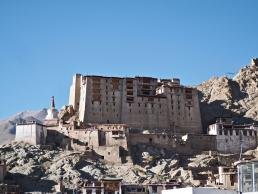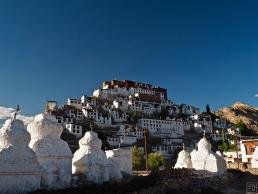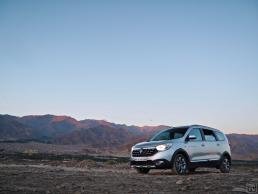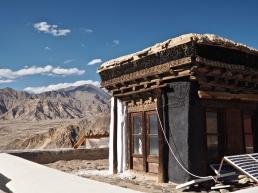Nestled in the higher reaches of the Himalayas, Leh is a dreamland. One of the highest cities in the world. Also the capital of Leh district & the biggest city in the Ladakh region. Hold on, this one’s special.

Four days of driving had brought us here. To Leh – the capital of Leh district. At 45,100 sq. km, Leh is one of the biggest districts in the country. Also one of the remotest. Sure, there’s an airport – shared with the Indian Air Force. But apart from that, it’s one of the most difficult places to get to. We’d taken the route via Srinagar, and there’s one more via Manali. Both these routes are shut for about 6 months in a year. A time when temperatures plummet to -40 degrees celsius and the landscape is blanketed in snow.

Ladakh is a high altitude desert. Average rainfall in the region is about 100mm in a year. To put that in perspective, it’s not unusual for a place like Bombay to receive that kind of rainfall in a days time.
For the time being though, the weather was perfect. We were in Leh in August, peak summer – temperatures ranging from 12 to 28 degrees. Clear blue skies and great visibility.

On our first day in Leh, we spent a good amount of time just relaxing. We were staying at one of the best hotels in Leh, the Grand Dragon Ladakh. Barely a kilometre away from the main market area, The Grand Dragon Ladakh offers great views of the Stok Kangri range. It’s got cozy rooms, three restaurants serving everything from North Indian, Continental to Ladakhi cuisine and ample parking space – a big big plus in a crowded city like Leh. I’d highly recommend this hotel if you’re planning a trip to Leh.
Leh is located at about 3500m above sea level or about 11500ft. It’s highly advisable to spend a day acclimatising to the high altitude and thinner air, especially if you’re flying into Leh. We’d taken the more slowly rising route via Srinagar, but chose to take it easy on the first day anyway. We did step out for a meal in the evening, and to explore the market area a bit. I’d recommend trying out the Himalayan Restaurant in the main market area. They serve tasty Thukpas and rich Kahwa tea – complete with saffron and cashew nuts.

On our second day in Leh, we visited the Leh Palace. Made of mud, sand, wood and stone, the Leh palace is perched on a hill and extends 9 storeys upwards towards the sky. It was built back in the 17th century, and was one of the tallest buildings in the region at the time. The architecture of the Leh Palace can best be described as stark. Against the blue sky, the palace appear like a shadow of grey stone and mud. Yellow window frames and red curtains break the mono-colour. Once the residence of the royal family of Ladakh, the Leh Palace is now a museum and open to the public at a nominal cost. On the inside are images of Leh from a forgotten era, as well as some architectural plans of the palace. The balconies offer panoramic views of the Stok Kangri range and Leh city, and make the climb up to the palace totally worth it.

“
The view from the Leh Palace is gorgeous. The Stok Kangri range in the distance and Leh city sprawling beneath you.
“
After the Leh Palace, we made our way to the Shanti Stupa, a Buddhist dome shaped, white structure that was constructed as part of the Pagoda Peace mission. Built post World War II, the peace pagodas are designed to provide a focus for people of all races and creeds, and to help unite them in their search for world peace. The Stupa sure has symbolic importance, but the location of the Stupa is what attracts most tourists. It provides panoramic views of Leh city & its surrounding areas.

“
Built post World War II, the peace pagodas are designed to provide a focus for people of all races and creeds, and to help unite them in their search for world peace.
“
On our 3rd day in Leh, we drove to Thiksey, a small village about 20km from Leh. Thiksey is famous for its monastery, and I must accept, it’s one of the best monasteries we encountered on our trip. Perched on a hill, the Thiksey monastery is the tallest structure in the area. It’s a colourful place that exudes warmth and friendliness.

It also showcases the starkness of Ladakh beautifully. Bare mountains stretching out on one side, and lush green fields next to the river on the other – in areas where civilisation has been established.
Top Tip: Keep 3-4 hours in hand at the very least, when visiting Thiksey. It deserves all the time you can give it.
On the way back from Thiksey, we visited Stok – a small, quaint town nestled in the foothills of the Stok Kangri range. It’s in Stok that you understand the nature of Ladakh and its way of life. Beautiful fields of wheat and barley, smiling faces, small houses made of mud and stone and snow clad mountains so close you could stretch out your hand and touch them.

If you have a few days in Leh, I’d definitely recommend that you visit Stok and spend some time walking around the place. It’s a charming place that’ll fill you with happiness with its simplicity and culture.
I’d also recommend that you make time to visit the Hemis monastery. Unfortunately, we couldn’t make time for Hemis on this trip. A reason to go back, if one was needed at all.

On our 4th day in Ladakh, we departed from Leh and travelled north towards Nubra. More on that in an upcoming article. Watch this space!






